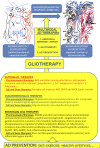The relationships between neuroglial and neuronal changes in Alzheimer's disease, and the related controversies II: gliotherapies and multimodal therapy
- PMID: 36407561
- PMCID: PMC9666878
- DOI: 10.1177/11795735221123896
The relationships between neuroglial and neuronal changes in Alzheimer's disease, and the related controversies II: gliotherapies and multimodal therapy
Abstract
Since the original description of Alzheimer´s disease (AD), research into this condition has mainly focused on assessing the alterations to neurons associated with dementia, and those to the circuits in which they are involved. In most of the studies on human brains and in many models of AD, the glial cells accompanying these neurons undergo concomitant alterations that aggravate the course of neurodegeneration. As a result, these changes to neuroglial cells are now included in all the "pathogenic cascades" described in AD. Accordingly, astrogliosis and microgliosis, the main components of neuroinflammation, have been integrated into all the pathogenic theories of this disease, as discussed in this part of the two-part monograph that follows an accompanying article on gliopathogenesis and glioprotection. This initial reflection verified the implication of alterations to the neuroglia in AD, suggesting that these cells may also represent therapeutic targets to prevent neurodegeneration. In this second part of the monograph, we will analyze the possibilities of acting on glial cells to prevent or treat the neurodegeneration that is the hallmark of AD and other pathologies. Evidence of the potential of different pharmacological, non-pharmacological, cell and gene therapies (widely treated) to prevent or treat this disease is now forthcoming, in most cases as adjuncts to other therapies. A comprehensive AD multimodal therapy is proposed in which neuronal and neuroglial pharmacological treatments are jointly considered, as well as the use of new cell and gene therapies and non-pharmacological therapies that tend to slow down the progress of dementia.
Keywords: AD multimodal treatment; Alzheimer´s disease; astroglia; astrogliosis; cell therapy; gene therapy; gliotherapy; microglia; microgliosis; neuroglia; oligodendroglia; pharmacological therapy.
© The Author(s) 2022.
Conflict of interest statement
The author(s) declared no potential conflicts of interest with respect to the research, authorship, and/or publication of this article.
Figures

References
-
- Alzheimer A. Über eine eigenartige Erkrankung der Hirnrinde, Allg. Zschr Psychiat. 1907;64:146-148.
-
- Achucarro N, Gayarre M. Contribución al estudio de la neuroglia en la corteza de la demencia senil y su participacion en la alteración celular de Alzheimer. Trab Lab Invest Biol Univ Madrid. 1914;12:68-83.
-
- Ramón y Cajal S. Degeneration and Regeneration of the Nervous System. New York, NY: Harper Press. 1969.
-
- Penfield W.Neuroglia: normal and pathological. In: Penfield W, ed. Cytology and Cellular Pathology of the Nervous System. New York, NY: PB Hoeberr Inc; 1932.
Publication types
LinkOut - more resources
Full Text Sources
Research Materials

